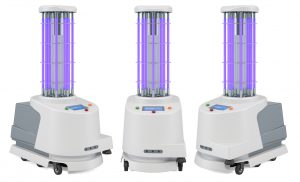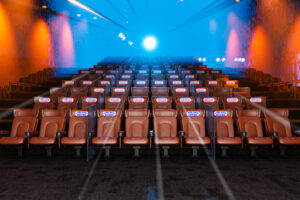Table of Contents
- 1 Powerful, Chemical-Free UV-C Surface Disinfection
- 2 How UV-C Surface Disinfection Works
- 3 What Affects UV-C Disinfection: Dose, Distance, & Surface Type
- 4 Safety & Regulatory Guidance
- 5 Best Practices for Safe UV-C Surface Disinfection
- 6 UV-C Surface Disinfection Applications Across Industries
- 7 UV-C Surface Disinfection Solutions from LightSources
Powerful, Chemical-Free UV-C Surface Disinfection
 LightSources and our European partner LightTech design and manufacture high-output germicidal surface disinfection UVC lamps that deactivate bacteria, viruses, molds, and spores on hard surfaces without chemicals or residue. Our proprietary quartz formulations, long-life electrode designs, and ceramic bases deliver superior UV output and long operating life for OEMs that build surface disinfection systems. These systems include autonomous robots, cabinets, and various restaurant and hospital room disinfection units.
LightSources and our European partner LightTech design and manufacture high-output germicidal surface disinfection UVC lamps that deactivate bacteria, viruses, molds, and spores on hard surfaces without chemicals or residue. Our proprietary quartz formulations, long-life electrode designs, and ceramic bases deliver superior UV output and long operating life for OEMs that build surface disinfection systems. These systems include autonomous robots, cabinets, and various restaurant and hospital room disinfection units.
The urgency of effective surface hygiene has never been clearer. Laboratory tests show that SARS-CoV-2 can survive for days on stainless steel and plastic, yet a modest UV-C dose of 10 – 24 mJ cm⁻² achieved ≥ 99.99 % reduction in viral titer on those same materials, and total inactivation on glass (NIH, 2021 Mar (1)). By integrating properly engineered UVC lamps, facilities can achieve rapid, repeatable disinfection cycles that augment labor-intensive chemical wipe-downs.
As a global supplier with vertically integrated glass fabrication, custom phosphor blending, and lamp assembly, the LightSources Group (LightSources, LightTech, Cerlux, Voltarc, and LCD Lighting) offers:
- Custom UV lamp geometries for robots, conveyors, and static fixtures
- Low-pressure mercury, high-output amalgam, medium-pressure, and Far-UVC 222 nm excimer solutions
- Rapid prototyping, OEM private-label programs, and ISO 9001:2015 registered quality manufacturing
Explore our full range of Germicidal UVC Lamps or speak with our engineers to specify the ideal lamp for your surface-disinfection project.
How UV-C Surface Disinfection Works
How 254 nm UV-C Disinfects Germs
Most germicidal UV lamps emit light at 254 nanometers, a specific UV-C wavelength that destroys bacteria, viruses, and other pathogens by damaging their DNA or RNA. When exposed to this light, microorganisms lose their ability to replicate, which is what makes UV-C such an effective disinfection tool.
One research study, Robust Evaluation of Ultraviolet-C Sensitivity for SARS-CoV-2 and Surrogate Coronaviruses, shows that SARS-CoV-2 and other coronaviruses are very sensitive to UV-C. Experimental data confirmed that SARS-CoV-2, HCoV-229E, HCoV-OC43, and mouse hepatitis virus (MHV) are all highly sensitive to 254 nm UV-C irradiation with a 1-log₁₀ reduction (90% inactivation) measured at 1.7 mJ/cm² for both SARS-CoV-2 and HCoV-0C43, 1.8 for HCoV-229E, and 1.2 for MHV. (NIH, 2021 Oct, (2)). That makes 254 nm UVC lamps ideal for many disinfection applications. LightSources offers custom design and prototype development to ensure proper fit and function for various disinfection systems.
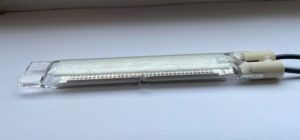 Far-UVC (222 nm) – A Safer Option for Occupied Spaces
Far-UVC (222 nm) – A Safer Option for Occupied Spaces
While traditional UV-C (254 nm) is effective, it can irritate skin and eyes with direct exposure. That’s why Far-UVC at 222 nm is gaining attention. This shorter UV wavelength, produced by excimer lamps with special filters, doesn’t penetrate the skin or eyes as deeply, making it a safer choice for use in places where people are present.
One study published in the American Journal of Infection Control found that 222 nm light can effectively inactivate SARS-CoV-2 on surfaces, suggesting it may be useful for continuous disinfection in high-traffic areas (AJIC, 2021 Mar, (3)).
Researchers at Columbia University and elsewhere have demonstrated that Far‑UVC light (~222 nm) effectively inactivates dangerous pathogens like MRSA, without damaging living tissue. One study explains that, unlike traditional UV-C, 222 nm light cannot penetrate the outer dead-cell layer of skin or eye tear films, yet easily reaches and neutralizes bacteria roughly 10–25 times smaller. (MedicalNewsToday, 2016, (4)). In animal tests, it successfully prevented MRSA infection in superficial wounds without causing skin injury, suggesting strong potential for safe, continuous disinfection in clinical environments. Learn more about Far UVC Light Bulbs: Effectiveness and Safety.
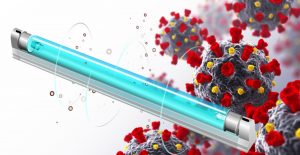 What Affects UV-C Disinfection: Dose, Distance, & Surface Type
What Affects UV-C Disinfection: Dose, Distance, & Surface Type
To disinfect surfaces effectively, UV-C must be applied at the right dose, depending on how far the lamp is from the surface, how long it runs, and what material is disinfected. Smooth surfaces like glass disinfect more easily, while stainless steel and plastic may need higher doses due to texture or reflectivity.
To ensure effective surface disinfection, it’s important to factor in the total UV-C dose delivered, which depends on lamp power, distance, exposure time, and surface material. Even small changes in angle or reflectivity can influence how much UV-C energy reaches a surface. That’s why system design plays a critical role. LightSources helps OEMs optimize performance by supporting lamp selection, reflector integration, and system validation to achieve consistent, reliable germicidal results.
Safety & Regulatory Guidance
UV-C surface disinfection is a powerful technology that must be applied responsibly. Governing agencies and scientific institutions offer detailed guidance to ensure UV-C systems are both effective and safe for use.
Exposure Safety
The CDC’s National Institute for Occupational Safety and Health outlines UVGI exposure limits to prevent harmful effects on skin and eyes (NIOSH, 2009, (5)). Direct exposure to germicidal wavelengths like 254 nm can cause damage if not properly shielded. UV disinfection systems must be designed to prevent human exposure above these limits, particularly in occupied spaces.
FDA Advisory on Consumer-Use Devices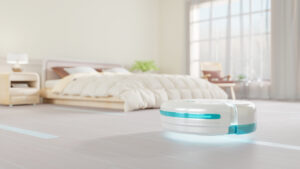
The FDA has issued warnings regarding low-output or poorly designed UV wands marketed to consumers. Many of these devices fail to deliver sufficient UV-C intensity or have unsafe designs that risk user exposure. According to the FDA, some UV products “require long exposure times to be effective, and many do not adequately shield users from harmful radiation.” For commercial and industrial applications, UV-C systems should always meet validated performance standards and be installed by professionals. (FDA, 2022 Sep, (6)).
Engineering Standards
The American Society of Heating, Refrigerating and Air-Conditioning Engineers, ASHRAE, provides a widely accepted engineering framework for air and surface disinfection building systems, such as HVAC-integrated UV-C or upper-room air disinfection. Chapter 62, Section 4, of the ASHRAE Handbook offers design guidance for the placement, irradiance levels, and system types for HVAC coil and drain pan surface irradiation. It reinforces how UV-C can complement conventional maintenance procedures while minimizing biological growth on coils and surfaces. For technical system designers, ASHRAE remains the go-to reference. (ASHRAE Handbook, 2019 (7)).
Best Practices for Safe UV-C Surface Disinfection
 Use Proper Shielding: Always ensure that UV-C systems are enclosed, interlocked, or placed in unoccupied areas during operation to prevent accidental exposure to skin and eyes.
Use Proper Shielding: Always ensure that UV-C systems are enclosed, interlocked, or placed in unoccupied areas during operation to prevent accidental exposure to skin and eyes.- Follow Exposure Guidelines: Reference CDC NIOSH exposure limits and ensure installations meet safety thresholds, especially for 254 nm lamps.
- Verify Equipment Quality: Choose commercial-grade lamps and systems tested for output, wavelength accuracy, and durability; avoid consumer-grade wands with unverified claims.
- Incorporate Protective Features: For added safety and compliance, consider Shatter ProTech™, LightSources’ proprietary lamp coating that contains glass and mercury if a lamp breaks. This advanced shield is a cost-effective way to protect people, products, and environments from contamination in high-risk applications.
- Ensure Maintenance and Training: Train staff on safe operation procedures and replace lamps according to manufacturer guidelines for sustained disinfection performance.
UV-C Surface Disinfection Applications Across Industries
The effectiveness of UV-C disinfection extends far beyond laboratories and cleanrooms. From hospitals and airports to kitchens and retail spaces, UV-C surface disinfection is being adopted across a wide range of industries for its proven ability to reduce pathogens without chemicals or residue.
Whether applied via fixed lamps, mobile robots, or integrated systems, germicidal UVC helps prevent the spread of viruses, bacteria, and fungi on high-touch surfaces and shared equipment. Each sector faces unique sanitation challenges, and UV-C offers flexible, powerful solutions that meet them head-on.
Hospitals & Healthcare
Hospitals and healthcare facilities must uphold strict disinfection and infection control standards. Numerous studies validate the efficacy of implementing UV light for surface disinfection in healthcare settings such as hospital patient rooms, emergency waiting rooms, operating rooms, restrooms, cafeterias, and hallways. UVC germicidal disinfection systems are also utilized to disinfect medical devices, achieving a significant reduction in contamination with near elimination of CFUs on nursing equipment. (AJIC, 2025, May (8))
There are many uses of hospital UV light disinfection that significantly reduce microbial threats in healthcare settings. One review published by the Journal of Infection Prevention highlights the effectiveness of UVC surface disinfection in an immediate patient environment, noting that the surface and room characteristics impact microbial reduction. (IPS, 2023 (9))
Flat surfaces and floors tend to demonstrate greater UVC disinfection effectiveness over handheld surfaces such as assist bars and bed controls, which showed reduced efficacy anywhere from 81 to 93%.
Healthcare-Acquired Infections
According to the Centers for Disease Control and Prevention (CDC, 2024 Nov, (10)), 1 in 31 patients at a hospital or healthcare facility will develop an infection acquired from the facility. Hospital-acquired infections (HAIs) may include superbugs resistant to antibiotics and contribute to acute care in hospitals, causing serious injury and even death. HAIs cause tens of thousands of deaths each year and contribute to billions of dollars in added health care costs.
According to a study published by the Journal of Hospital Infection (JHI, 2025, Feb (11)), UVC light demonstrated potential in reducing HAIs, with effectiveness varying based on infection control strategies, pathogen types, and environmental settings. These studies conclude that UVC disinfection for hospitals is most effective when used with manual, systematic cleaning and disinfection protocols.
Candida Auris
Candida Auris is a persistent and multidrug-resistant fungus that poses a significant threat in healthcare facilities, especially in high-dependency areas. It spreads easily among patients in these settings through contact with contaminated surfaces or equipment, and from direct contact with infected or colonized individuals. C. auris can cause severe, sometimes life-threatening infections, particularly in patients with weakened immune systems or those receiving complex medical care.
An NIH study on Candida auris found that UV-C exposure was highly effective, with exposure time and distance as key variables for complete inactivation (NIH, 2019 (12)). LightSources offers more information about surface disinfection with UV light to combat Candida Auris.
SARS-CoV-2
COVID-19 raised global awareness of the importance of fast, reliable surface disinfection methods. Studies show that SARS-CoV-2 can survive on surfaces like plastic, steel, and glass for extended periods, making it a persistent threat in healthcare, transit, and public settings. UV-C lamps have been scientifically proven to inactivate the virus by damaging its RNA, effectively preventing replication. With the proper UVC germicidal lamps, UVC light does kill COVID.
LightSources supplies specialized UV-C lamps for SARS-CoV-2 disinfection used in air and surface disinfection systems. These lamps help reduce contamination risks in high-traffic and high-touch healthcare environments.
Learn More – UV Light Disinfection in Hospitals
UV Disinfection Robots
UV-C disinfection robots are increasingly used in commercial, industrial, and healthcare facilities to provide fast, automated surface disinfection. These mobile units are equipped with high-output UV-C lamps and can be programmed to disinfect large spaces, including operating rooms, patient suites, and high-traffic areas, without human oversight. Their mobility and broad coverage make them ideal for environments that require consistent turnover and strict hygiene protocols.
UV disinfection robots are utilized to reduce viral transmission in numerous applications worldwide, helping to prevent the spread of infection in various public spaces. UVC robots are effective in the fight against viral infections such as beta coronaviruses, including the SARS-CoV-2 virus that causes COVID-19, Severe Acute Respiratory Syndrome (SARS), Middle East respiratory syndrome (MERS), and superbugs like Methicillin-resistant Staphylococcus aureus, MRSA.
UV robots can be programmed to roam the halls of supermarkets, schools, bus stations, airports, and other public spaces as autonomous virus killers on wheels. These robots use sensors and mapping software to travel safely through complex areas, delivering uniform UV coverage without direct human control, making them especially useful in facilities with changing layouts or high foot traffic.
UVC robots are a viable and cost-effective solution providing long-term value with automatic disinfection. There are numerous advantages of using UVC robots in various applications and industries. The key to effective disinfection relies upon the quality of the UVC germicidal lamps. LightSources offers a wide range of germicidal UVC lamps for use in UV robots and other UV disinfection systems.
Learn More – UV Disinfection Robot Lamps
Food Irradiation & Kitchen Environments
 Exposing food items to UV ionizing radiation is a safe and effective method of reducing harmful germs that cause food poisoning without affecting food quality. UV irradiation reduces bacteria and other harmful pathogens in food items and stops the replication of germs. Just as pressure cooking or pasteurizing milk kills bacteria without affecting food quality, food irradiation makes food safer without affecting food quality.
Exposing food items to UV ionizing radiation is a safe and effective method of reducing harmful germs that cause food poisoning without affecting food quality. UV irradiation reduces bacteria and other harmful pathogens in food items and stops the replication of germs. Just as pressure cooking or pasteurizing milk kills bacteria without affecting food quality, food irradiation makes food safer without affecting food quality.
Food irradiation is a safe and effective method approved by the FDA (EPA, 2025 May, (13)) to improve food safety and shelf life. It uses ionizing radiation to:
- Kill harmful bacteria like Salmonella and E. coli, reducing the risk of foodborne illness
- Extend freshness and shelf life by slowing spoilage and decomposition
- Control pests on imported produce without the need for chemical treatments
- Delay ripening and sprouting in fruits and vegetables like potatoes
- Disinfect food for long-term storage, useful in healthcare settings for patients with compromised immune systems
Food irradiation is a safe and effective way to reduce the microbial load on food processing and packaging lines to mitigate the risk of contamination and prevent cross-contamination. UV surface disinfection offers a chemical-free method that is safe for use on food-contact surfaces, including belts, utensils, and conveyor equipment. Learn more about the lamps for UV food disinfection and the various types of foods that benefit from food irradiation.
UVC surface disinfection is widely used on food processing and packaging lines and in commercial kitchens.
Restaurant UV Disinfection
 Restaurants face rigorous sanitation demands to prevent foodborne illness, maintain health code compliance, and protect customers. UV-C surface disinfection helps foodservice operators reduce microbial load on prep stations, cooking equipment, and dining areas without the use of harsh chemicals.
Restaurants face rigorous sanitation demands to prevent foodborne illness, maintain health code compliance, and protect customers. UV-C surface disinfection helps foodservice operators reduce microbial load on prep stations, cooking equipment, and dining areas without the use of harsh chemicals.
Germicidal UVC lamps are used to disinfect food-contact surfaces, cutting boards, utensils, and walk-in coolers. They’re especially useful during overnight sanitation cycles or in high-risk areas like raw meat prep stations and dishwashing zones.
UV systems can also be installed in kitchen exhaust hoods to reduce grease buildup and neutralize airborne contaminants before they recirculate into the kitchen or dining room. UV lamps in kitchen exhaust systems provide many benefits by preventing bacteria and grease buildup. This self-cleaning technology provides a cleaner, healthier, and safer commercial kitchen by eliminating odors and mitigating the risk of grease fires.
UV-C is a powerful supplement to standard restaurant cleaning protocols, helping to maintain a cleaner environment with fewer chemicals and less labor.
Learn More – UV Light Restaurant Disinfection
Malls & Theaters
High-traffic environments like shopping malls, theaters, and entertainment venues pose unique disinfection challenges. Frequent hand contact with seating, handrails, counters, and payment stations increases the risk of microbial transmission. UV-C surface disinfection offers an efficient and scalable solution to enhance cleaning efforts across these large public spaces.
By installing UV-C fixtures in HVAC systems, under escalator rails, or within cleaning carts for after-hours sanitation, facility managers can reduce surface contamination on a wide scale. UV-C’s non-chemical, residue-free nature makes it suitable for use in settings where customers and staff circulate frequently.
Learn how LightSources helps facility managers implement effective disinfection strategies for commercial venues.
Learn More – UV Disinfection in Malls and Theatres
UV Disinfection at Home
UV-C disinfection has become increasingly popular for residential use, offering homeowners a convenient way to reduce bacteria and viruses on everyday surfaces. UV-C disinfection systems limit the spread of germs within the home, from countertops and kitchen tools to electronics and shared devices.
Disinfecting boxes and cabinet-style UV units are commonly used to disinfect phones, keys, and personal items. UV-C air and surface purifiers are also being adopted in home HVAC systems and baby nurseries to maintain a cleaner living space. Use caution when purchasing household UVC disinfection products; opt for fully enclosed devices with safety features like automatic shut-off switches to prevent accidental exposure to UVC radiation. The FDA advises against UV wands, which can emit unsafe radiation levels and lack sufficient safety features. (FDA, 2022 Sep, (6)).
LightSources provides compact, efficient germicidal UVC lamps for home disinfection products, designed to integrate seamlessly into consumer appliances and wellness devices.
Learn More – UV Light for Home Applications
UV-C Surface Disinfection in HVAC Systems
Air-handling units in HVAC systems are prone to microbial buildup, particularly on cooling coils, drain pans, fans, and humidifiers, where moisture can support mold and bacteria growth. Traditional maintenance methods like chemical washing and mechanical scrubbing are often labor-intensive, environmentally harmful, and can degrade equipment over time.
UV-C surface disinfection offers a safer, lower-maintenance alternative. Installed within HVAC systems, UV-C lamps continuously irradiate moist interior surfaces, effectively preventing biofilm formation without toxic chemicals or physical abrasion. ASHRAE research shows that this method controls microbial growth and helps maintain airflow and coil efficiency by reducing pressure drop and improving heat transfer.
Because coil surfaces are stationary, a large UV-C dose can be delivered over time with relatively low irradiance, making this approach highly cost-effective for long-term maintenance. (ASHRAE Handbook, 2019 (7)).
Learn More – UV HVAC Surface Disinfection
UV-C Surface Disinfection Solutions from LightSources
UV-C surface disinfection plays a critical role in limiting the spread of harmful microbes across a wide range of industries, from hospitals and food processing facilities to public spaces, commercial, and residential settings. When designed and applied correctly, UV-C systems can deliver high log-reduction of bacteria, viruses, and fungi on high-touch surfaces, shared equipment, and interior HVAC components.
LightSources offers a full portfolio of germicidal UVC lamp technologies to meet these diverse needs, including:
- Low-pressure mercury lamps – Proven 254 nm disinfection with high efficiency
- Amalgam lamps – High-output and long-life performance for commercial systems
- Medium-pressure UV lamps – Broad-spectrum UV ideal for industrial and high-flow applications
- 185 nm ozone-producing lamps – Enhanced oxidation for complex contaminants
- Far-UVC (222 nm) excimer lamps – Effective disinfection for occupied spaces with added safety
Whether you’re integrating UVC into automated robots, HVAC systems, or stationary enclosures, LightSources can help you engineer a high-performance solution.
LightSources offers decades of experience designing and manufacturing advanced germicidal UVC lamps for surface disinfection across critical industries. We provide expert support, proprietary technologies like Shatter ProTech®, and the broadest selection of UVC lamp types to meet your specific requirements.
LAMP PRODUCT DATA:
UV Germicidal LampsLAMP APPLICATIONS:
UV Germicidal ApplicationsLightSources delivers innovative germicidal UV-C lamp solutions designed for effective disinfection in even the most demanding environments. Our UV disinfection lamps are effective in healthcare, food safety, transportation, consumer applications, and more, with customized lamp types for each use case. Contact us to speak with an engineer about the right germicidal UVC lamps for your surface disinfection system.
References
- Biasin, M., Bianco, A., Pareschi, G., et al. (2021). UV-C irradiation is highly effective in inactivating SARS-CoV-2 replication. PubMed. https://pubmed.ncbi.nlm.nih.gov/33807521/
- Sabino, C.P., Ball, A.R., Baptista, M.S., et al. (2021). Robust evaluation of ultraviolet-C sensitivity for SARS-CoV-2 and surrogate coronaviruses. PubMed. https://pubmed.ncbi.nlm.nih.gov/34668746/
- Kitagawa, H., Nomura, T., Nazmul, T., et al. (2020). Effectiveness of 222-nm ultraviolet light on disinfecting SARS-CoV-2 surface contamination. American Journal of Infection Control. https://www.ajicjournal.org/article/S0196-6553(20)30809-9/fulltext
- Zayed, A. (2016). Far-UVC light may prevent MRSA infections. Medical News Today. https://www.medicalnewstoday.com/articles/310818
- NIOSH. (2009). Environmental Control for Tuberculosis: Basic Upper-Room Ultraviolet Germicidal Irradiation Guidelines for Healthcare Settings. Centers for Disease Control and Prevention. https://www.cdc.gov/niosh/docs/2009-105/pdfs/2009-105.pdf
- U.S. Food and Drug Administration. (2021). Beware of Ultraviolet (UV) Wands That Give Off Unsafe Levels of Radiation. FDA Consumer Update. https://www.fda.gov/consumers/consumer-updates/beware-ultraviolet-wands-give-unsafe-levels-uv-radiation
- ASHRAE. (2019). Chapter 62: Ultraviolet Air and Surface Treatment. ASHRAE Handbook—HVAC Applications. https://www.ashrae.org/file%20library/technical%20resources/covid-19/i-p_a19_ch62_uvairandsurfacetreatment.pdf
- Zhou, M., Sharma, A., McClung, C., et al. (2024). Utilizing ultraviolet light to disinfect high use nursing equipment. American Journal of Infection Control. https://www.ajicjournal.org/article/S0196-6553(24)00907-6/abstract
- Resendiz, M., Blanchard, D., & West, G.F. (2023). A systematic review of the germicidal effectiveness of ultraviolet disinfection across high-touch surfaces in the immediate patient environment. Journal of Infection Prevention. https://journals.sagepub.com/doi/abs/10.1177/17571774231159388
- Centers for Disease Control and Prevention. (2022). Healthcare-Associated Infections Data Portal. CDC HAI Data. https://www.cdc.gov/healthcare-associated-infections/php/data/index.html
- Peters, A., McEwen, M., McMullan, B., et al. (2025). Impact of ultraviolet light disinfection on reducing hospital-associated infections: A systematic review. Journal of Hospital Infection. https://www.journalofhospitalinfection.com/article/S0195-6701(25)00028-3/fulltext
- de Groot, T., Puts, Y., Berrang-Ford, L., et al. (2019). Killing of Candida auris by UV-C: Importance of exposure time and distance. PubMed Central. https://pmc.ncbi.nlm.nih.gov/articles/PMC6850319/
- U.S. Environmental Protection Agency. (2023). Food Irradiation. EPA Radiation Protection: RadTown. https://www.epa.gov/radtown/food-irradiation#about-food-irradiation



